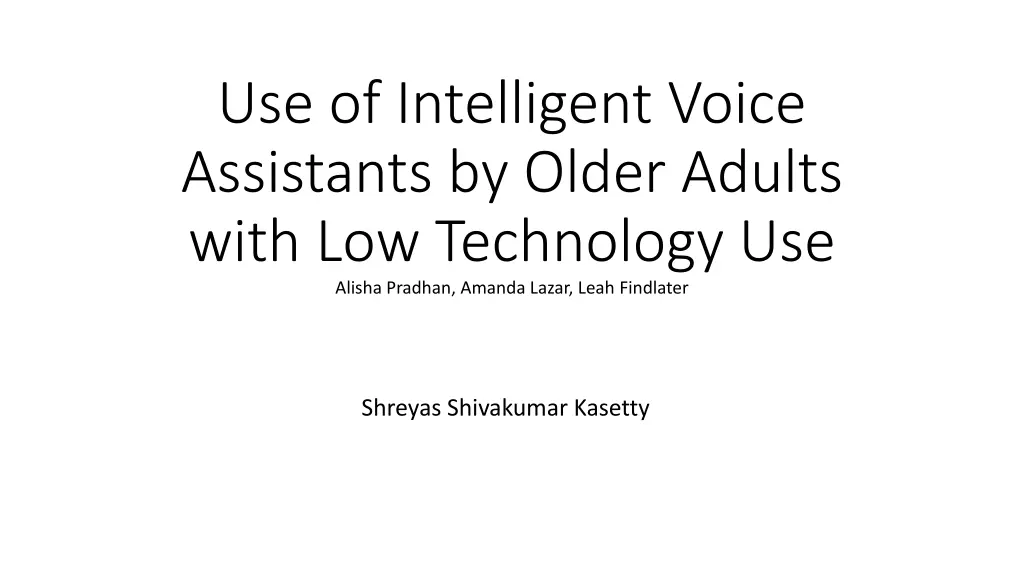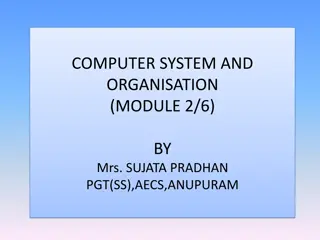
Empowering Older Adults Through Voice Assistants
Explore how smart speakers like Amazon Echo can enhance accessibility for older adults with limited digital experience. Understand their perceptions, challenges, and usage patterns to improve technology for this user group.
Download Presentation

Please find below an Image/Link to download the presentation.
The content on the website is provided AS IS for your information and personal use only. It may not be sold, licensed, or shared on other websites without obtaining consent from the author. If you encounter any issues during the download, it is possible that the publisher has removed the file from their server.
You are allowed to download the files provided on this website for personal or commercial use, subject to the condition that they are used lawfully. All files are the property of their respective owners.
The content on the website is provided AS IS for your information and personal use only. It may not be sold, licensed, or shared on other websites without obtaining consent from the author.
E N D
Presentation Transcript
Use of Intelligent Voice Assistants by Older Adults with Low Technology Use Alisha Pradhan, Amanda Lazar, Leah Findlater Shreyas Shivakumar Kasetty
Introduction Research Goal: Explore how voice assistants in smart speakers (e.g., Amazon Echo) can make technology more accessible for older adults who rarely use digital devices. Purpose: Understand how older adults perceive and use voice assistants, and identify challenges to improve these technologies for this user group. Research Questions: How do older adults with limited tech experience view smart speakers? What are the common uses of these devices? What challenges do they face, and how can we address them?
Methodology Participants Total: 7 participants (1 male, 6 female). Age: 65+ years old. Technology Usage: Used digital devices less than once a day.
Methods of Data Collection 1.Weekly Semi-Structured Interviews 1. Frequency: 3 interviews per participant (initial, mid-point, final). 2. Duration: 30-75 minutes per interview. 3. Topics: Device usage, challenges, benefits, and security concerns. 2.Daily Diary Entries via Automated Calls 1. Frequency: 18 calls over 22 days. 2. Response Rate: Average of 16 responses per participant. 3. Average Call Duration: 1 minute 28 seconds. 4. Purpose: Capture daily interactions and reflections on usage. 3.Usage Logs 1. Total Commands Logged: 4,150 commands. 2. Filtered Commands Analyzed: 1,049 commands after removing repeated or unclear commands. 3. Categories: Information requests, weather checks, alarms, etc.
Data Analysis Data Analysis Thematic Coding: Qualitative analysis of interview transcripts and diary entries. Total Codes: 23 primary codes (e.g., device usage, challenges, privacy). Coding Agreement: Cohen s kappa = 0.87 (high inter-rater reliability). Three research team members were involved in creating the initial code book, which was validated by a multi step validation process.
Results and Key Findings Increased Comfort Over Time Initial hesitancy turned into comfort by the end of the study. Participants felt more confident using Alexa, appreciating the ease of voice commands. Primary Uses Information finding: 34.9% Unstructured conversation: 13.6% Playing music: 13.3% Checking the weather: 9.8% Health information was a major category (16% of info queries). Supporting Memory Participants relied on Alexa for small reminders but often used backup methods like paper notes.
Major Challenges Voice Recognition Issues Participants had to repeat commands due to Alexa's difficulty recognizing variations (e.g., confusing Alexis for Alexa ). Command Structure Complexity Participants struggled to remember specific keywords for features like reminders or alarms. Compound commands (e.g., stop music and tell me the weather ) were often misunderstood, causing frustration. Limited Discoverability of Features Difficulty finding certain features, such as emergency skills. Desire for a printed manual to help discover Alexa s capabilities. Dependence on Paired Device Actions like deleting items required using the paired tablet, which some participants were less comfortable with.
Comparison with Traditional Technology Confidence Boost Participants found Alexa simpler and faster than computers, which boosted their confidence in using tech. Some participants, who typically needed help with computers, felt empowered to use Alexa independently. Accessibility Benefits Voice interface was useful for participants with arthritis or vision challenges. Avoided need for typing or adjusting text size. Shift in Technology Use Habits Alexa replaced some traditional devices for daily tasks, such as checking the weather (instead of TV). Participants found Alexa convenient and appreciated how it easily integrated into their routines.
Design Improvements Enhancing Health Information Credibility Participants often trusted or needed to verify health information from Alexa but lacked resources. VUIs (Voice User Interfaces) should incorporate credibility indicators, such as source reliability scores or verified health information, to support users with limited digital literacy. Improving Memory Support Features Current reminder, timer, and alarm features are not fully utilized due to concerns over reliability (e.g., internet dependency) and complex commands. Design should consider collaborative memory strategies (allowing family or caregivers to set reminders) and simplify command structures to improve usability. Addressing Discoverability and Consistency in Commands Participants struggled with inconsistent and hard-to-remember commands across Alexa features and third-party skills. Designers should ensure consistent keyword usage and explore visible command options (e.g., projected interfaces or companion screens) to enhance discoverability.
Conclusion This study shows that voice assistants can improve technology access for older adults, making digital interaction more approachable.






















